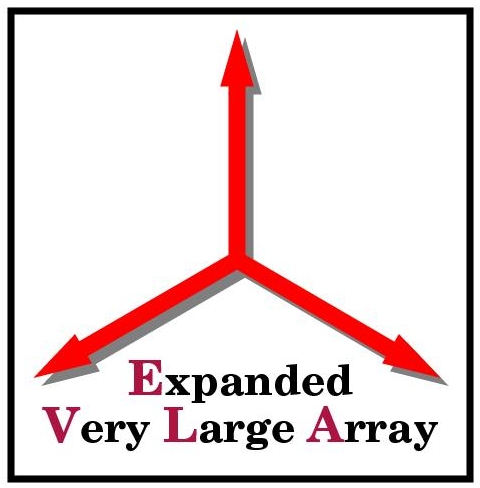| NRAO ASTRO2010 |
| Overviews | |
| EVLA Phase I | |
| EVLA Phase II | |
| VLA 2010 Initiatives | |
| Recent Developments | |
| Latest News | |
| December 2008 EVLA Science Workshop | |
| User Resources | |||
| News For Proposers | |||
| Transition Reports | |||
| CASA User Software | |||
| Project Organization | |
| EVLA Advisory Committee Meetings | |
| SAGE Meetings (Scientific Advisory Group for EVLA) | |
| NSF EVLA Reviews | |
| Phase I Project Book | |
| Computing/Software | |
| Project Documents | |
| Important Project Documents | |
| Memo Series | |
| EVLA Phase I Design Reviews | |
| Meetings/Workshops | |

|
Very Large Array 2010 Initiatives: |
||
Currently on time and on budget for completion at the end of FY2012, the first phase of the Expanded Very Large Array Project (EVLA) will offer the astronomical community an order of magnitude increase in sensitivity above the original VLA, contiguous frequency coverage between 1 and 50 GHz, and incomparable flexibility in the set up of the new WIDAR correlator.
We propose a trio of relatively low-cost (< $12M total cost, FY09 dollars) enhancements to the EVLA:
- (i) Adding 20 new pads for existing EVLA antennas to provide an
ultra-compact array configuration that will offer enhanced speed and
surface brightness sensitivity, improved sidelobe response, greatly
improved image fidelity (by a factor of 7), as well as improved
mosaicing. Scientific applications of these new capabilities will
include large-angle low-surface brightness surveys and mosaic
observations of large sources, ideally carried out in conjunction with
the GBT and other large, single-dish antennas, imaging of the
Sunyaev-Zeldovich cosmic microwave background decrement in galaxy
clusters, HI and non-thermal
imaging of nearby galaxies, the imaging of Galactic chimneys and shell
structures, maps of Zeeman splitting of HI, molecular, and
recombination lines, the imaging of comet emission, and the imaging of
diffuse synchrotron emission from particle acceleration sites
throughout the universe.
Supplementary Materials:
- EVLA E-Configuration (264KB PDF) 2008-02-15 R. Perley
- EVLA-II Goals (2.2MB PDF) 2004-12-15 R. Perley
- EVLA-II Science (2.5MB PDF) 2001-08-23 M. Rupen
- (ii) A low-frequency improvement program that will replace the
VLA's "legacy" 327 MHz and 74 MHz receiver systems with modern systems
having lower noise, wider instantaneous bandwidth, and improved
feeds. The proposed upgrade would especially enhance the capabilities
of EVLA's unique long baseline configurations, and would offer
enormously improved scientific access to studies of cosmic
reionization, radio relics and halos, the lifecycle of AGNs, continuum
and spectroscopic observations of high-redshift sources, free-free and
synchrotron-self absorption, as well as Faraday rotation, scattering
and interstellar medium studies in the Milky Way and other galaxies.
Supplementary Materials:
- EVLA Low-frequency extension (7.9MB PDF) 2008-02-15 R. Perley
- EVLA-II Science Goals w/low frequency (1.4MB PDF) 2002-06-10 R. Perley
- EVLA-II Science (2.5MB PDF) 2001-08-23 M. Rupen
- (iii) Adding a suite of compact water vapor radiometers (WVRs) to
the EVLA to improve the array's phase stability at frequencies above 8
GHz by correcting for rapid tropospheric phase errors produced by
water vapor fluctuations. Based on a proven prototype design, these
devices will use measured fluctuations in the brightness temperature
of the 22 GHz atmospheric water line to derive short-term phase
corrections that will improve the quality of observations (especially
those on longer baselines), increase observing efficiency at high
frequencies, and greatly reduce seasonal constraints on array usage.
Supplementary Materials:
- EVLA Memo 73 - results of WVR tests (1.3MB PDF) 2004-08-09 C. Chandler et al.
- EVLA Memo 74 - proposal for WVR (296KB PDF) 2004-07-08 C. Chandler et al.
Each of these enhancements will greatly increase the scientific reach of the EVLA, has extremely low technical risk, and will strongly leverage the US astronomical community's ongoing and long-standing investment in this unique instrument.
Note that there is also a proposal for a more ambitious bridge to a next-generation high-frequency array. The North American Array concept is being submitted by the NRAO New Initiatives Office in partnership with institutions across the astronomical community.
See also the NRAO Astro2010 Page for more on what NRAO is submitting to the review panel(s).
Last modified by Steven Myers (smyers AT nrao DOT edu) on: Thursday, 05-Feb-2009 11:42:08 MST
